How to stop the breakthrough of the army group "Got"
Here came the 6th and 23rd tank divisions of the 57th Panzer Corps, which were opposed by the 302nd and 126th Rifle Divisions of the 51st Army. Connection with the Paulus group was planned southwest of st. Tundutovo.
Breakthrough Soviet Defense
The Soviet Stavka and the command of the Stalingrad Front expected that the enemy would strike the main blow from the Nizhne-Chirskaya area. This was the most logical step. From Kotelnikovo to the inner ring of the encirclement of the German army was 110 km, Nizhne-Chirskaya was closer on 45 km. This ensured the success of the first strike of the German strike force. For the offensive, the German 6-I tank division was divided into three motorized infantry groups and one strong armored group of Günesdorf (commander of a tank regiment). The armored group consisted of a tank regiment and infantry battalion on armored personnel carriers. Subsequently, with the spread of armored personnel carriers, the formation of armored groups became the usual solution for German mobile units.
After artillery preparation, the enemy broke through the defenses in the band of the 302 Infantry Division at the gun station Kurmoyarsky. The German armored group not only broke through the defenses and marched forward, but also attacked Soviet forces in the rear of the Upper Apple. With the onset of darkness, the advanced units of the 6 Tank Division entered separate sectors towards the southern bank of the r. Aksai, and the 23-I tank division — to the area north of Nebykov. The success of the first day of the offensive even surprised the Germans. H. Scheubert, commander of a tank company in the 6 Division, wrote: “Given our own strength, fully confirmed by the success of the breakthrough, we still expected more resistance, if not at the most advanced, then later in the lowland near Nebykovo station. However, this lowland used for the railway to Stalingrad and limited to deep beams could hardly be bypassed by motorized troops, which gave the defenders certain advantages. ”
The command of the army group "Don" believed that the main task was solved - the Soviet front was broken. Further development of the offensive will not cause problems. However, the enemy underestimated the strength of Soviet mechanized connections in this area. The defense of the 302 Infantry Division collapsed, its broken units retreating in small groups. In the defensive orders of the 51 Army, a large breach was formed. A.I. Eremenko demanded that the commander of the 51 Army, Major-General N. I. Trufanov, hold the line occupied by his troops and restore the position in the sector of the 302 th rifle division. The 235 I flamethrower tank brigade and the 87 Infantry Division were sent to reinforce the army from the front reserve. Also, December 12 was decided to deploy the 4 th mechanized corps on the Kotelnikovsky direction. The hasty action of the Soviet command is evidenced by the fact that all the armored units were thrown at the reflection of the enemy strike. Thus, the 235-I separate flamethrower tank brigade was originally intended to suppress the knots of resistance of the German infantry in the area of Stalingrad. Flame-retardant tanks should not be used as linear machines. But now they had to face with enemy tanks.
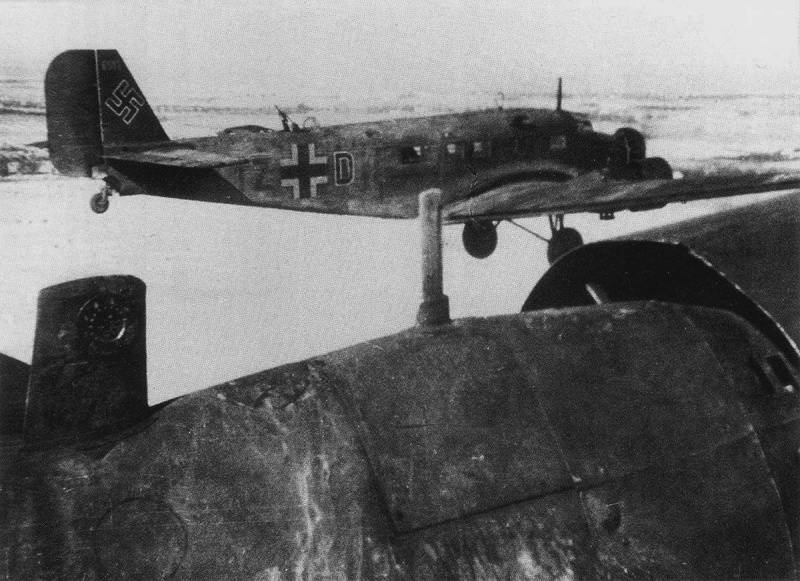
German transport planes Yu-52 (Ju 52 / 3m) 1-th squadron 1-th special-purpose squadron (1.KGrzbV1) deliver cargo to the surrounded parts in Stalingrad. Photo source: http://waralbum.ru/
December 13 Germans have developed an offensive. 6-I tank division captured the bridgehead on the river. Aksai at Zalivsky, from here part of the forces advanced to the farmstead of Upper Kumsky and captured him. The 23-I tank division, advancing from the Nebykov area, also went out to the river, seizing a bridgehead at the railway and highway bridge at Kruglyakov. In the book of Scheibert it was noted: “In seven hours, the Gunersdorf group advanced 25 km, capturing ... the crossing over the r. Aksai and creating a bridgehead depth to 10 km. She was far ahead of the main forces of both her own and the 23 division ... The advancing 23 tank division, while crossing, Aksay encountered resistance from Russian tanks and was forced to ask for help from the 6 tank division. To this end, two tank companies of the 6 Tank Division were moved into the strip of the 23 Division. By the end of the day, we managed to create two more bridgeheads on the northwestern bank of Aksai. ”
The command of the Stalingrad Front on December 14 planned to launch a counterstrike on the flanks of the enemy grouping that had broken out ahead. It was supposed to strike in converging directions in two groups. The first consisted of the 4 th mechanized corps, the 235 th tank brigade, the 234 th tank regiment and the 87 th rifle division. The 13 tank corps was to attack this group. To support mobile troops, 100 fighters and attack aircraft of the 8 Air Force were allocated.
Thus, with the release of troops of the army group "Goth" to the river. Aksai there was a real danger of breaking through the outer front of the encirclement and access to the encircled Paulus army. At the turn of the river. Aksai-Esaulovsky launched a fierce struggle, the outcome of which largely depended on the further development of events on the Soviet-German front. The German General Mellentin evaluates the significance of these battles: “During this period, events full of tragedy took place, historical the value of which is difficult to overestimate. It will not be an exaggeration to say that the battle on the banks of this unknown river led to the crisis of the Third Reich, put an end to Hitler’s hopes for the creation of an empire and was a decisive link in the chain of events that predetermined the defeat of Germany. ” Indeed, the fate of the 6th German army, the possibility of rebuilding the German front near Stalingrad, the outcome of the 1942 campaign and the future of the 1943 campaign depended on the outcome of this battle. The Wehrmacht was desperately trying to maintain a strategic initiative.
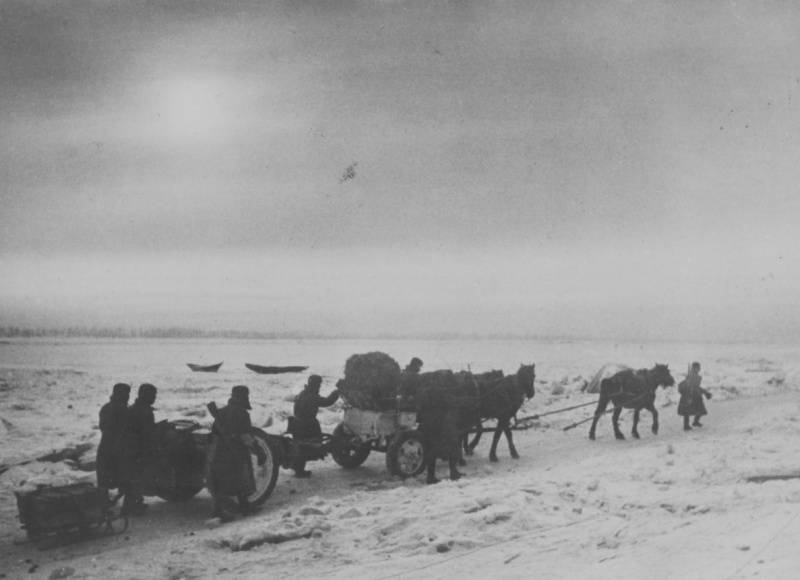
Soviet gunners go at 76-mm regimental gun model 1927, mounted on a snowy road in the area of Stalingrad
The Soviet Stavka saw this threat well. Already in the evening of December 13, the original plan of Operation Saturn was canceled with access to Kamensk-Rostov. Now the main attack was directed not to the south towards Rostov, but to the south-east, to Morozovsky. That is, a larger-scale operation, with cutting off the withdrawal paths of Army Group A in the Caucasus, was canceled. It was necessary to prevent the escape of the 6 Army of Paulus. Therefore, the 6 th mechanized corps was handed over to the Stalingrad front to use it against the German assault force, which was torn to the rescue of the Paulus army. The next day there was another major change in plans. Late in the evening of December 14 with a directive addressed to Vasilevsky, Stalin demanded that, in view of the changed situation in the south, the implementation of the first stage of Operation Ring to defeat Paulus’s blocked army was postponed. 2-th Guards Army was offered a forced march to move south and position in the rear of the units operating against the enemy Kotelnikovsky group.
Thus, in the event of the defeat of the mechanized corps of the Stalingrad Front, fresh forces had to stand in the way of the German strike force, including the Malinovsky Guards Army. The problem was that by the evening of December 13, when the Germans reached the line of the river. Aksai, 2-I Guards was still on the way. Some troops were still moving in echelons, some were on the march to the unloading area. December 15 2-I Guards Army was on the march, smeared on iron and dirt roads. Only by the evening of December 16, the army of Malinovsky had reached the level of the unloaded echelons 120 (they were unloaded north of Stalingrad) from 156. And from the places of unloading it was necessary to still go to the area south-west of the city. Trailers were traditionally immediately lagging behind, there was no fuel for vehicles, there was no connection between the parts. That is, if the Goth army group had broken through the Volsky Mechanized Corps and other troops, it would have been a disaster - the Germans would have the opportunity to beat Malinovsky’s selective army in parts (more than 90 thousand soldiers).
On the morning of December 14, a fierce battle unfolded with a new force. German troops sought to develop success in the area of the farm Upper Kumsky, which became the main node of the struggle. Here are located the most convenient roads from south to north to Stalingrad. The path to the enemy from the north was blocked by the 1378 th infantry, 234 th tank regiments, 235 th flamethrower tank and 20 th separate fighter brigade. From the air of the attacking enemy, Soviet attack aircraft, which operated in groups of 4 — 6 aircraft, attacked. As a result, the 4 th mechanized corps of General V.T. Volsky, advancing towards the advancing German troops, fought in the area of Upper Kumsky and Vodyansky. The 13 tank corps came right up to the enemy in the Biryukovsky racket area and, joining the battle, pulled over part of the forces of the 23 tank division. Thus, throughout the day, the 51 Army waged heavy battles with the advancing Goth assault group. X. Scheubert noted that 14 in December 1942 was the day of "the beginning of the three-day tank battle in the Kalmyk steppes, one of the biggest and fierce tank battles of the second world war."
On the same day, the troops of the 5 Shock Army launched an offensive against the enemy operating in the Rychkovsky, Verkhne-Chirsky area. After a stubborn battle, Major-General P. A. Rotmistrov’s 7 Tank Corps, 258-th and 4-th Guards Rifle Division discarded the Germans from the bridgehead, which facilitated the position of the 51-th army in the Kotelnikov direction.
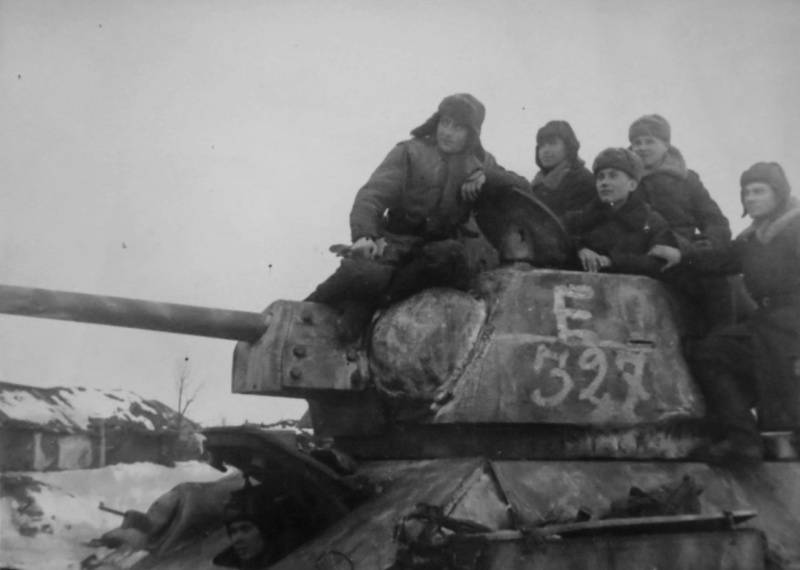
Tankers of the 24 of the Soviet Tank Corps on the T-34 armor during the liquidation of the group of German troops surrounded at Stalingrad
15 December fierce battles continued. The 4 th mechanized corps (at that time it had more than 100 tanks) with reinforcement units led the battle for the Upper Kumsky farm, inflicting a counterstrike on the elongated wedge of the 6 th tank division. The armored group of the 6 division was in a difficult position. She had little infantry, the bulk of the infantry divisions were still on the southern coast of Aksai and covered the flanks. In the second half of the day, our troops drove the Hitlerites out of the Upper Kumsky farm and drove them to the r. Aksay. X. Scheiber, describing this fight, remarks: "Our mood was very nasty ... Rage, depression, combined with doubts and nervousness, took possession of us." Citing an excerpt from the combat magazine of the 11 Tank Regiment, he writes: “By order of a division, the town (Upper Kumsky — A. S.) was evacuated. Under the cover of darkness, the Gunersdorf group retreated to the south to replenish its ammunition and fuel. This day was worth a regiment of heavy victims. " Thus, our troops were able to stop the enemy at the turn of the river. Aksay.
Continuing the fight
16 December, both sides were preparing for the continuation of the battle and the struggle was on separate sections. The troops of the Stalingrad Front stubborn defense did not allow the exit of the enemy to the river. Myshkov, ensuring the approach and deployment of the 2 Guards Army. The fighting took place in the area of Verkhne-Kumsky and Zhutov 1. The most fierce battles were in the Upper Kumsky area. Here, the German 6 Panzer Division was opposed by the 1378 Infantry Regiment under the command of Lieutenant Colonel M. S. Diasamidze, reinforced by the 1 Division of the 1058 Artillery Regiment.
The Germans could not penetrate the Soviet defense. Mr. Durr noted: “The December 16 attack of the corps tanks that were part of the Gunersdorf brigade at the top. Kumsky ended in failure. In Upper Kumsky, they were surrounded by part of the 6 armored division. The attack was reflected in the massive use of new, well-disguised anti-tank weapons by the enemy. ”
The German command did not abandon attempts to break through to their own. The encircled Paulus army was to deliver a counter strike when the forces of Gotha approaching it approached a distance of 30 km. The shock group was 50 km from the target, it seemed that a little more and the problem would be successfully solved. On December 17, the 6th, 17th (which completed the transfer to the combat area) and the 23rd Panzer Divisions, supported by infantry formations, launched an attack in the Verkhne-Kumsky area. German tanks and motorized infantry supported by aviation, fiercely tried to break through the rivers Aksai and Myshkova - tributaries of the Don. The terrain was difficult for battle - the steppe was cut by deep ravines and ravines, covered with deep snow.
6-I and 23-I armored divisions struck to the north, so that, bypassing Zagotskot, again seize Upper Kumsky. At the same time, motorized infantry with the support of assault guns was advancing from Zalivsky. However, the Germans, having advanced a little, soon met with fierce resistance and could not take Zagotskot. Overcoming the stubborn resistance of the Soviet soldiers, the enemy still came to the Upper Kumsky, but here again he met a strong anti-tank defense. Despite the support of aviation, the German tanks could not advance further. Here the defense was kept by the gunners of the artillery battalion of the 59 mehbrigade and the 383 of the anti-tank artillery fighter regiment. Strong counterattacks by our tank crews - the 55-th separate tank regiment of Lieutenant Colonel A. A. Aslanov - forced the enemy to return to their original positions.
Scheubert noted: “The Russians made an attempt to cut off our escape route. They acted that day very skillfully. And we, under the threat of coverage, were compelled to withdraw under the cover of darkness. Guided by tracer bullets, we retreated to the south, halfway across the motorized infantry of our division. The whole enterprise turned out to be a blow. ”
Also on this day, the 360 th mechanized brigade and the 1378 th rifle regiment distinguished themselves, repelled a number of fierce frontal attacks of the enemy in the collective farm area. March 8 and 130,1 Heights, 137,2. As a result, the German troops could not capture the Upper Kumsky this time. The 20 fighters of a separate anti-tank artillery brigade under the command of Major P.S. Zhelamsky fought heroically. Tank fighters defended at 146,9 height, at s. Thunderclave. The brigade, restraining the enemy, suffered heavy losses. On the same day, units of the 13 tank corps of Major General T. I. Tanaschishin were fighting to the west of Kruglyakov. Despite serious losses, the 4 Cavalry Corps continued to fight.
The troops of the 2 th Guards Army of the 17 December with the help of two divisions and one mechanized corps were just beginning to focus on the defensive line. By order of the commander of the Stalingrad front, the 87 th rifle division, the 4 th cavalcore corps and the 4 th mechanized corps with all the reinforcement means were subordinated to the commander of the 2 th Guards Army. The troops of the 2 Guards Army were assigned the task of smashing the enemy’s Kotelniki grouping on the approaches to the outer fortified contour of Stalingrad, with the immediate task of reaching the Aksai River.
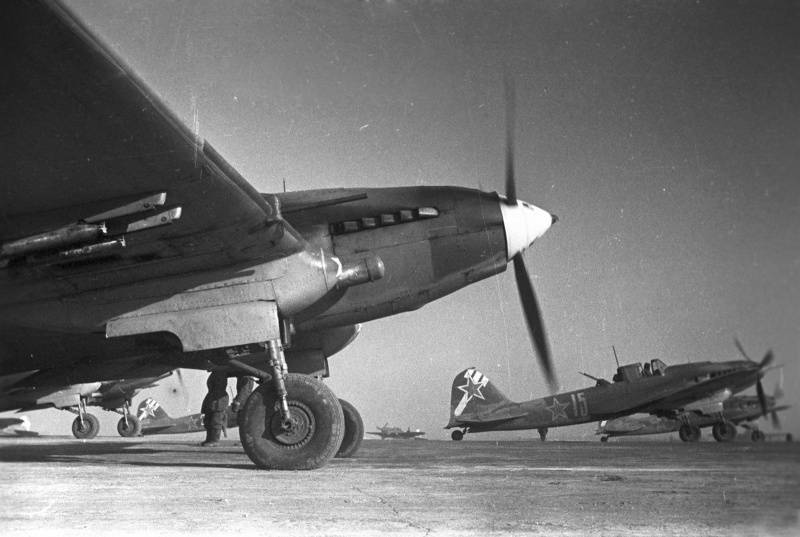
Soviet attack aircraft Il-2 take off on a combat mission at Stalingrad
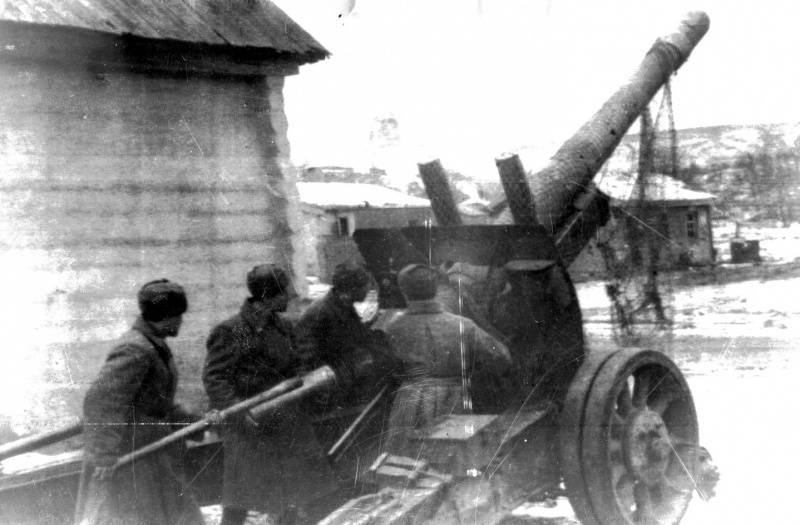
Soviet artillerymen, at the rate of sergeant Bardadymov, are firing at enemy subsidiaries and subordinates on the outskirts of Stalingrad from an 152-mm howitzer ML-20 howitzer 1937 of the year
On December 18, the enemy threw an 17 tank division (54 tank) pulled up to the battle area. Forcing the river. Aksai in its lower reaches, in the area of Generalovsky, the Germans advanced to the collective farm named. March 8, in 7 km west of Upper Kumsky. It housed the headquarters, the political department and the medical unit of the 36 mekhbrigad 4 mehkorpusa. They came under the blow of the enemy. The death of all people was avoided, but the settlement had to be left. In the evening, our troops regained their position, knocking out the enemy. On this day, the German 6 Panzer Division resumed its attack on the Upper Kumsky. Attacks of German tanks and motorized infantry were supported by massive strikes of assault and bomber aircraft. The 1378 Infantry Regiment under the command of Lieutenant Colonel Diasamidze took the brunt of the attack and repelled three enemy attacks. Fighters of the 382 anti-tank artillery regiment and all other units and units of the 4 mechanized corps also fought bravely.
In the course of a fierce clash, more than once, Soviet soldiers showed unique examples of heroism worthy of historical paintings. So, among them were 24 fighter, defending the height of 137,2. The rifle company of the 3 battalion of the 1378 rifle regiment under the command of Senior Lieutenant N. P. Naumov, together with a platoon of anti-tank guns that had joined her at night, repelled the Germans one by one. Our soldiers destroyed 18 tanks and many enemy soldiers and officers. Only in the afternoon, the Germans managed to seize the height of the 137,2. Heroes have died the death of the brave. By the end of the day, the enemy that had broken through had been thrown off by the attack of the AASlanov tank regiment and the reserve part of Diasamidze, and the defense at 137,2 was restored.
In the evening of December 18, a radiogram came from the front headquarters addressed to General Volsky, informing him of the decision taken by the Supreme High Command to give the corps the title of the Guard. The 4 th mechanized corps was converted to the 3 th Guards mechanized.
Thus, the 18 of December, the Germans could not break through the Soviet defense, faced with violent resistance from the Soviet troops. “The 6 Tank Division,” writes G. Dörr, “slowly moved forward to the south-eastern outskirts of Upper Kumsky; however, on this day they failed to master it. ” The path to Stalingrad for the troops of Manstein was closed.
It is worth noting that the corps of Volsky so successfully fought with the armored "fist" of the enemy, as he was already a real mechanized unit, that is, he had full mobility. The situation was also fundamentally different from the summer of 1942, when Soviet mobile armored formations, poor in infantry, could not independently restrain mechanized formations of Germans. Now the Soviet mechanized corps had tanks, infantry, and some artillery.
December 19 battle continued with the same force. After a strong artillery and air preparation, the Germans continued their attacks. 17-I and 6-I tank divisions, despite the losses, gnawed their way in the area of Werne-Kuma. The situation was extremely tense. From 7 to 15 hour. 30 min. Soviet guards repelled 5 German attacks. Separate groups of enemy tanks made their way to the areas of Nizhne-Kumsky and Chernomorov. 59-I and 60-I brigades were in the semicircle, the enemy tanks broke through to the rear of the battle formations of the corps. General Volsky decided to give orders to the brigades to leave the settlements of Verkhne-Kumsky and the collective farm to them. March 8 and start a withdrawal to a new line of defense. By evening, the 4 units of the mechanized corps began to focus at the turn of Chernomorov - Chapura - Gromoslavka. They retreated with fighting, restraining the onslaught of the enemy. At night, separate groups of soldiers and commanders continued to retreat to the new line of defense. So, on the night from 19 to December 20, the 1378 Infantry Regiment left the encirclement, the units of which moved to the Gromoslavka area.
The violent resistance of the body of Volsky and other parts played a role. While they were bleeding to restrain the enemy’s strike force rushing forward, the 150 echelons of the 2 Guards Army arrived and unloaded in the Stalingrad area. Its compounds occupied the defense on the north bank of the river. Myshkov: 98-rifle division of 1-th Guards Rifle Corps - in the area Nizhne-Kumsky, Ivanovka, 3-I Guards Rifle-Division 13-th Guards Rifle-Corps - in the area Ivanovka, Kapkinka, height marked 104,0. The 2 Guards Mechanized Corps was concentrated in the rear of these divisions. However, the army of Malinowski reached the line of defense after the 180-kilometer march, carried out in severe weather conditions. In addition, part of the equipment was still on the way; there was a shortage of ammunition. But there was no other way out; the advance units immediately fought with the enemy.
As a result, the Soviet troops in these fierce battles achieved undoubted success. The time for concentrating the 2 Guards Army was won. The Soviet mechanized units were able to close the gap during the battle of Upper Kumsky, and behind them, even before the arrival of the army, Malinovsky created a fairly strong barrier. For him, the troops of the 5 shock army and the forces that had previously blocked Paulus’s army were used. In fact, on the “Winter Thunderstorm” plan a big and fat cross was put.
The only time period when Goth's troops could be successful was the period from 14 to 16 December. If, at that time, the German assault force had broken the resistance of the 4 th mechanized corps, the 6 German tank division could have broken through to the meeting point, accessible from inside the “boiler”. If Volsky’s mechanized corps had been defeated at that time, the enemy’s 57 tank corps would have had the opportunity to make its way to Stalingrad. However, the Soviet mechanized case withstood a terrible blow.
An important factor was also the attacks of the Don Front, which linked the main part of the tanks and part of the strike power of Paulus 6. Manstein himself already understood that the Red Army had retorted the deblocking blow. He reported to Hitler: “It would be impossible for the 57 tank corps to unite alone with the 6 army, not to mention maintaining this connection. The last option is the breakthrough of the 6 Army in the south-west direction. At least most of the troops and moving weapon army will be saved. " However, the Wehrmacht had not yet lost a whole army, and the command of the 6 Army itself had not yet seen the possibility of a complete catastrophe in order to abandon the wounded and almost all the property and go for a breakthrough in order to preserve the army’s core capability.
The chief of staff of the Don group of the army, Schulz, had to persuade the command of the 6 Army to break through, while there was still a chance, and regardless of the success of the deblocking group. In the negotiations that took place on December 20 between the Chief of Staff of 6 Army Schmidt and Schultz, he said that “The point of view of Field Marshal (Manstein) is such that the advance of the 6 Army should begin the sooner the better. You can’t wait for Goth to get closer to Buzinovka ... ” However, Schmidt and Paulus waited. The command of the 6 Army considered that the accumulation of fuel required an 5 - 6 days to launch an offensive. That is, the attack of the 6 Army could have followed no earlier than December 25-26. And the chances of success of the breakthrough quickly decreased with each passing day.
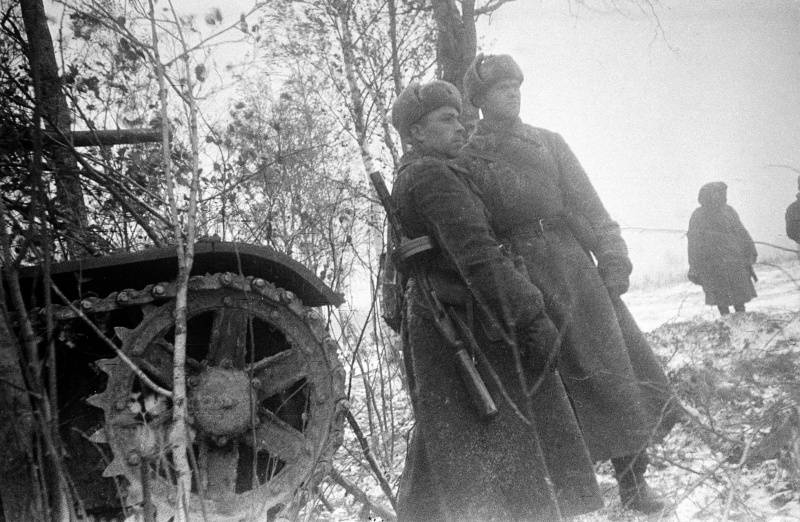
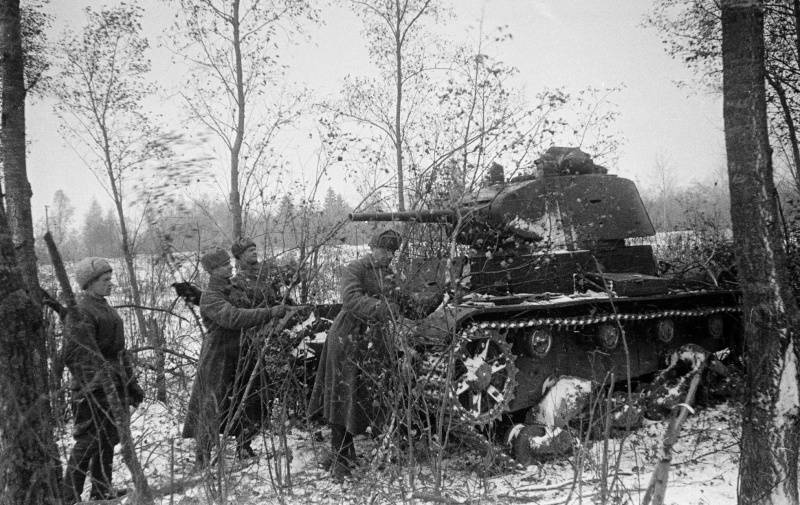
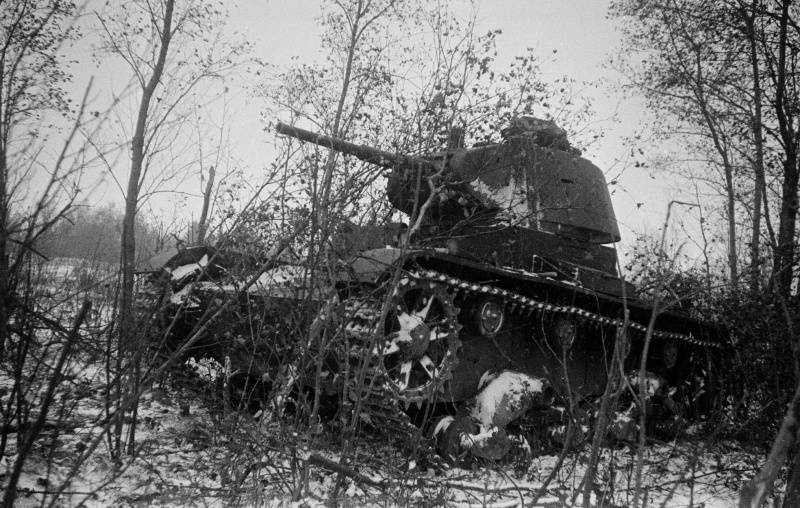
Soviet soldiers at the T-26 tank on the outskirts of the liberated village near Stalingrad
To be continued ...
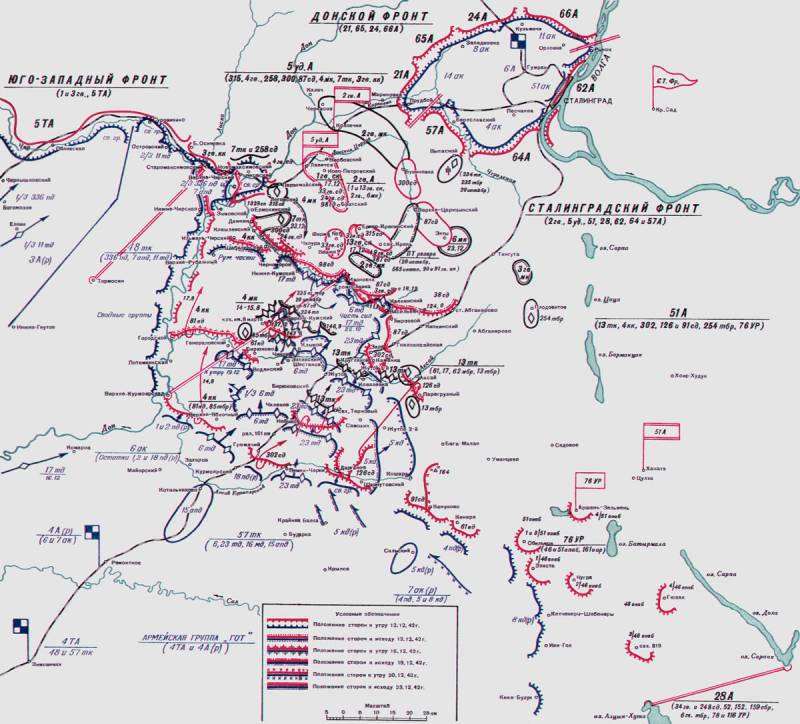
Information